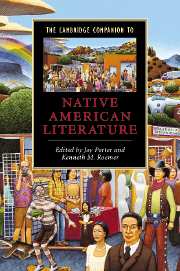Book contents
- Frontmatter
- Introduction
- Timeline
- Part I Historical and cultural contexts
- Part II Genre contexts
- 4 Non-fiction prose
- 5 Native American life writing
- 6 America’s indigenous poetry
- 7 Pre-1968 fiction
- 8 Fiction
- 9 American Indian theatre
- Part III Individual authors
- Bio-bibliographies
- Further reading
- Index
- Series List
6 - America’s indigenous poetry
from Part II - Genre contexts
Published online by Cambridge University Press: 28 May 2006
- Frontmatter
- Introduction
- Timeline
- Part I Historical and cultural contexts
- Part II Genre contexts
- 4 Non-fiction prose
- 5 Native American life writing
- 6 America’s indigenous poetry
- 7 Pre-1968 fiction
- 8 Fiction
- 9 American Indian theatre
- Part III Individual authors
- Bio-bibliographies
- Further reading
- Index
- Series List
Summary
Casting light on ancient philosophies, demonstrating their survivance (to use Gerald Vizenor's term), American Indian poets had come into their own by the late twentieth century. Like Native singers and storytellers, indigenous poets writing in English or tribal languages transmit ancient mythologies and migratory and settlement histories spanning thousands of years.
Rooted in oral traditions, including tribal stories and songs, Native poetry has also been nurtured by a century and a half of American Indian poetry written in English, by American and English poetics, and by international literary traditions and forms. Yet, despite five centuries of colonial efforts to reshape or silence indigenous voices, Native poets continue to speak from a tribal perspective. As Craig Womack states in Red on Red: Native American Literary Separatism (1999), “tribal literatures are not some branch waiting to be grafted onto the main trunk. Tribal literatures are the tree, the oldest literatures in the Americas, the most American of American literatures.”
John Rollin Ridge, Jane Johnston Schoolcraft, E. Pauline Johnson, Alexander Posey, and Zitkala-a are predecessors, but they have had less influence on Native poetics than have indigenous stories and songs. Taught in the Euro-American tradition, these five adopted formal English verse, often alluding to classical Greek and Roman mythology. Nevertheless, while their style is European, they all advocated respect for American Indians in poems that reflect their cultures’ lives before and after colonization.
- Type
- Chapter
- Information
- The Cambridge Companion to Native American Literature , pp. 145 - 160Publisher: Cambridge University PressPrint publication year: 2005
- 1
- Cited by



